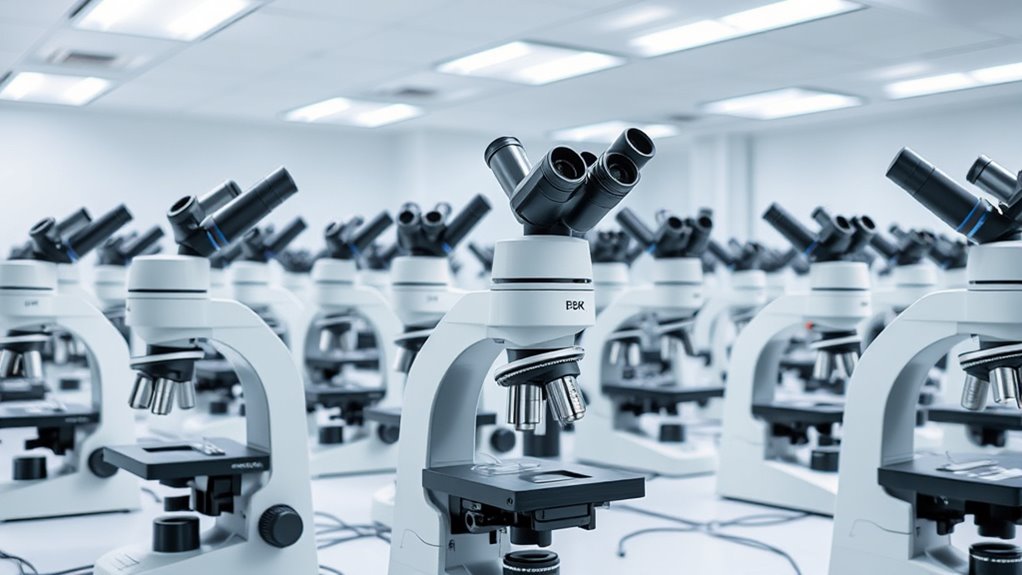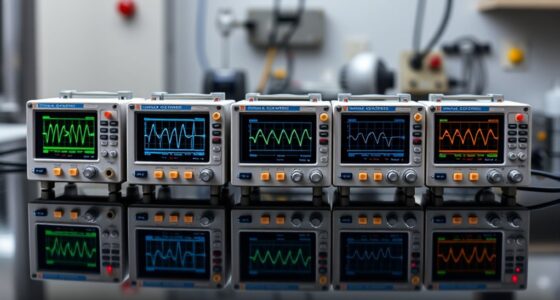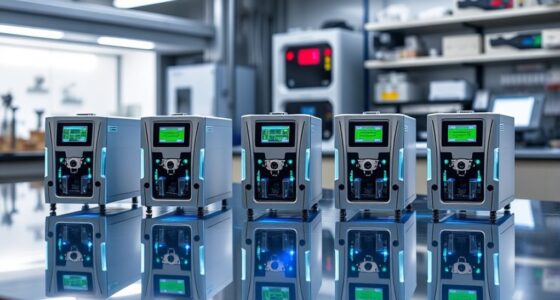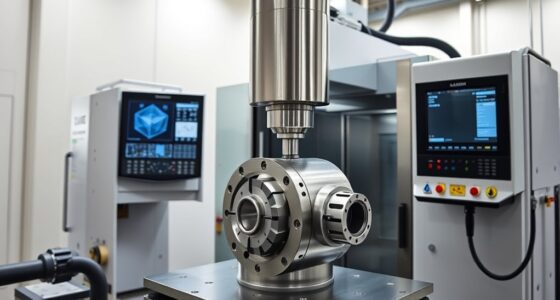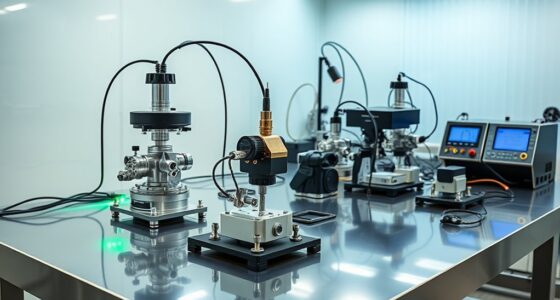If you’re looking for the best inverted microscopes for cell culture in 2025, I’ve found top models with advanced optics, high-resolution cameras, and ergonomic designs that make detailed biological observation easier. They feature infinity-corrected systems, bright LED illumination, large stage spaces, and compatibility with digital documentation tools. Whether for research, teaching, or clinical work, these microscopes help you see cell details clearly. Keep going to learn more about each model’s features and how they can support your work.
Key Takeaways
- Look for models with high NA objectives, infinity correction, and anti-reflective coatings for sharp, detailed cell culture imaging.
- Prioritize microscopes with high-resolution digital cameras and compatibility for live streaming and documentation.
- Choose models with large, stable stages, long working distances, and ergonomic designs for easy handling of petri dishes and culture chambers.
- Opt for microscopes featuring adjustable LED illumination and filters to enhance contrast and visibility of live cells.
- Consider user-friendly interfaces, motorized stages, and versatile accessories suitable for advanced cell culture research.
AmScope 40-400X Inverted Biological Microscope
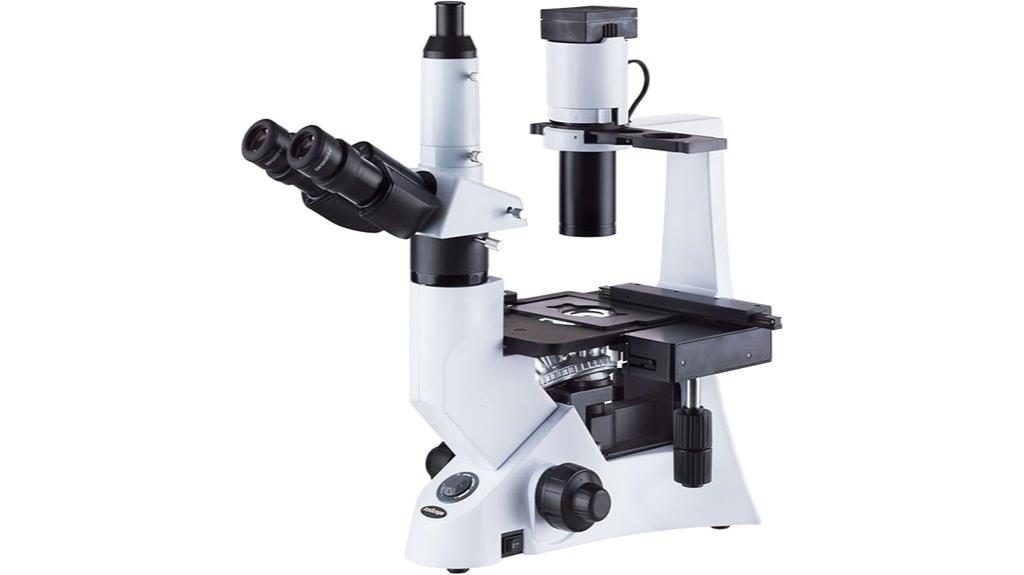
If you’re working with cell cultures or multiwell samples, the AmScope 40-400X Inverted Biological Microscope is an excellent choice because it offers a large, spacious stage and precise control for viewing large specimens. Its 160mm x 250mm stage with X-Y coaxial controls easily handles multiwell plates and bigger samples. The infinity-corrected optical system with plan achromatic objectives ensures sharp, clear images at magnifications from 40X to 400X. The 30-degree inclined head and high-eyepoint wide-field eyepieces provide comfortable viewing, while the built-in illumination and filters support versatile experiments. Overall, it’s a reliable, user-friendly microscope for biological research.
Radical Inverted Biology Microscope with Camera Port

The Radical Inverted Biology Microscope with Camera Port stands out for researchers who need high-quality imaging combined with flexibility in live cell observation. It features an infinite optical system with objectives like LWD 4x and phase contrast 20x, 10x, and 40x, all with long working distances for easier handling. Its trinocular head tilts at 30 degrees and rotates 360 degrees for comfortable viewing. The LED illumination provides bright, even lighting, while the built-in camera port with a 0.5x adapter makes documentation simple. Designed for petri dishes and culture chambers, it’s a versatile choice for advanced live cell microscopy.
Best For: researchers and educators requiring high-quality live cell imaging, flexible observation angles, and documentation capabilities in biological microscopy.
Pros:
- Infinite optical system with multiple objectives including phase contrast for versatile imaging
- Long working distance objectives facilitate easy handling of petri dishes and culture chambers
- Built-in camera port with 0.5x adapter simplifies image capture and documentation
Cons:
- Slightly complex setup due to multiple objectives and optical components
- May require additional equipment for advanced digital imaging beyond basic documentation
- Limited to 3-watt LED illumination, which might be less bright for some applications needing intense lighting
Trinocular Microscope with HD USB Camera and Mechanical Stage
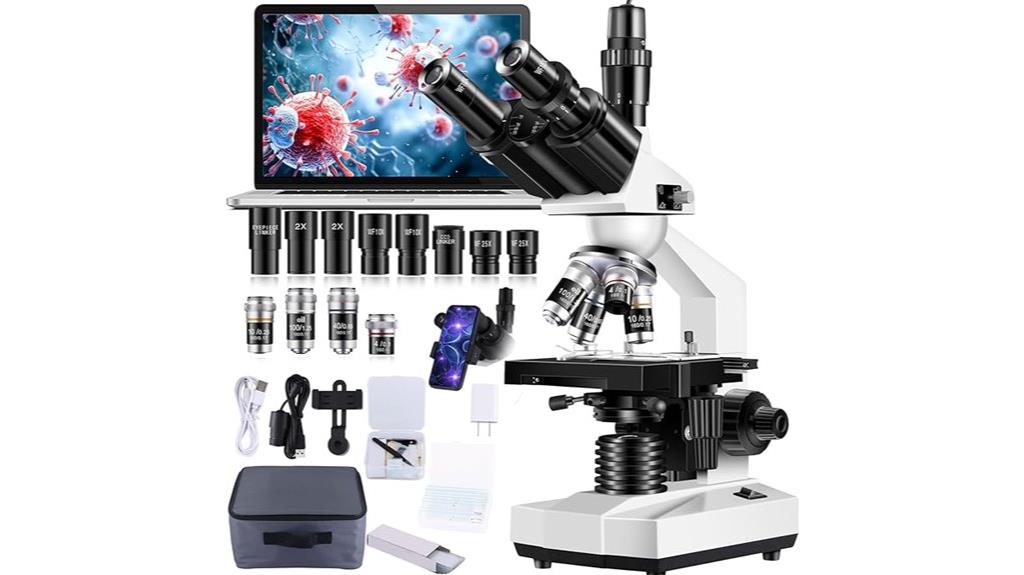
A trinocular microscope with an HD USB camera and mechanical stage offers an excellent combination of high-resolution imaging and precise control, making it ideal for researchers, educators, and serious hobbyists engaged in cell culture studies. It features a broad 40X-5000X magnification range, with high-quality optics, including infinity optical system and achromatic lenses, which ensure sharp images with excellent color accuracy. The double-layer mechanical stage and adjustable focusing allow precise positioning and focus. Equipped with a 1.5MP camera supporting 1080p video, it’s perfect for documentation. Its ergonomic design, wide-angle eyepieces, and versatile accessories make it a reliable, user-friendly tool for detailed biological analysis.
Best For: educators, researchers, and serious hobbyists seeking a versatile microscope with high-resolution imaging and precise control for biological and scientific applications.
Pros:
- High magnification range from 40X to 5000X with quality infinity optical system and achromatic lenses for clear, true-color imaging.
- Equipped with HD USB camera supporting 1080p video, ideal for documentation and sharing.
- Ergonomic design with wide-angle eyepieces, adjustable pupil distance, and double-layer mechanical stage for comfortable and precise observation.
Cons:
- Assembly can be challenging due to unclear instructions and small parts.
- Some users report debris on lenses or mechanical sticking, requiring maintenance.
- Lacks rubber eyeguards and has a short phone holder screw, which may affect user comfort and device stability.
AmScope IN300TC-10M Digital Trinocular Microscope
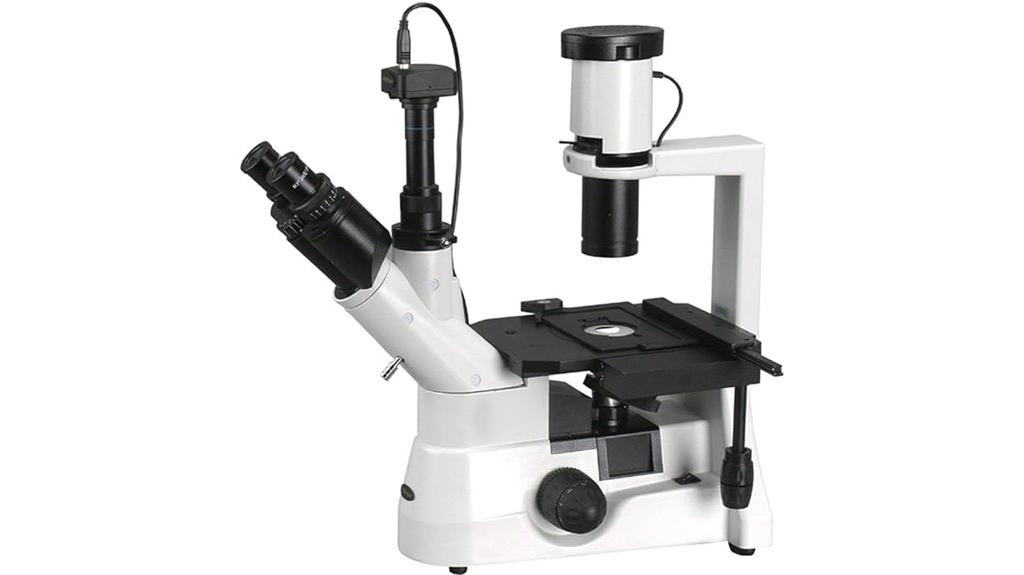
For researchers needing detailed cell culture observations with extended working distance, the AmScope IN300TC-10M Digital Trinocular Microscope stands out as an excellent choice. Its magnification range of 40x to 1000x allows for versatile imaging, while the 10MP camera with USB 2.0 output simplifies capturing and sharing images. Designed specifically for biological specimens, it features a long working distance, a trinocular head with high-eyepoint widefield eyepieces, and phase-contrast objectives. The adjustable LED illumination and precise mechanical stage further enhance its usability. Overall, this microscope offers reliable performance for in-depth cell culture analysis and documentation.
Best For: researchers and biologists needing detailed cell culture observations with extended working distance and high-resolution imaging capabilities.
Pros:
- Offers a wide magnification range from 40x to 1000x suitable for various biological applications
- Equipped with a 10MP camera and USB 2.0 output for easy image capture and sharing
- Designed with a long working distance ideal for observing specimens in petri dishes, well plates, or vials
Cons:
- May be more expensive compared to basic microscopes without digital imaging features
- Requires an external power source and computer connection for image analysis
- Heavier and bulkier due to its trinocular design and additional components
Compound Microscope, 40X-2500X Research Microscope with Dual LED Lighting
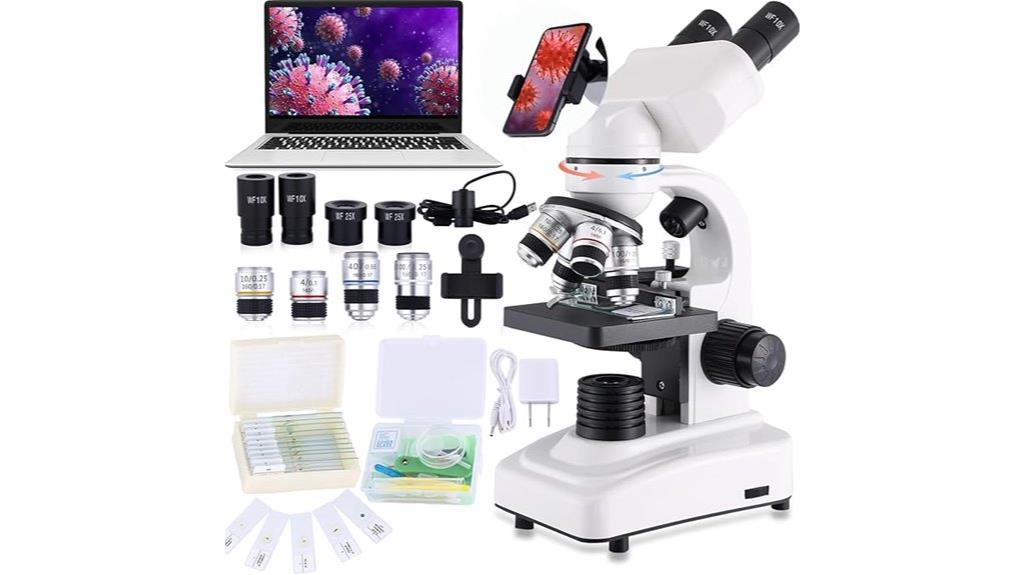
If you’re seeking a research-grade microscope with versatile magnification, this compound microscope offering 40X to 2500X zoom is an excellent choice. It features an ultra-wide-angle binocular eyepiece for sharp images and a large field of view, reducing eye fatigue during long sessions. The dual LED lighting system provides adjustable top and bottom illumination for clearer cellular and subcellular observation. Its mechanical stage allows precise sample positioning, while the telescopic lens protects samples from lens overlap. Compact and lightweight, it’s suitable for students, hobbyists, and basic research, though some users report issues with image clarity at high magnifications and build quality concerns.
Best For: hobbyists, students, and amateur scientists seeking an affordable, versatile compound microscope for basic biological observation.
Pros:
- All-optical ultra-wide-angle binocular eyepiece offers clear, sharp images with a large field of view.
- Adjustable dual LED lighting system enhances illumination for cellular and subcellular details.
- Compact and lightweight design makes it portable and suitable for extended use.
Cons:
- Some users report inconsistent image quality and focus issues at higher magnifications.
- Build quality concerns include loose components, dirty lenses, and fragile focusing mechanisms.
- Digital imaging features and software compatibility are often unreliable or poorly supported.
Microscope for Adults, 40X-5000X Magnification with HD USB Camera
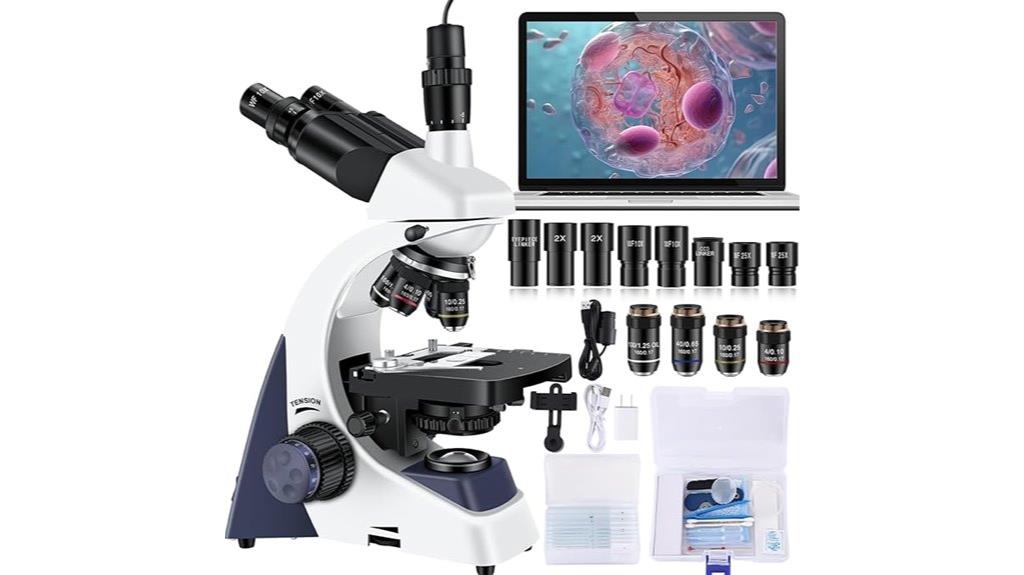
This microscope stands out for its impressive 40X-5000X magnification range combined with an HD USB camera, making it ideal for serious adult users engaged in biological research, educational activities, or pet hospital inspections. Its lab-grade trinocular design supports detailed observations, with features like dual mechanical stages, adjustable pupil spacing, and high pixel electronic eyepieces ensuring clear, accurate imaging. The true 195 achromatic lenses eliminate color interference, while the wide-angle optical system offers comfortable viewing. Compatible with cell phone and computer image capture, it’s a versatile tool for professionals needing high-resolution visuals, backed by durable construction and user-friendly adjustments.
Best For: serious adult researchers, science educators, veterinarians, and pet enthusiasts who require high magnification and clear imaging for biological, educational, or inspection purposes.
Pros:
- Offers a wide magnification range of 40X-5000X with high-quality achromatic lenses for precise detail.
- Supports HD USB camera and device compatibility for professional image capture and sharing.
- Features durable construction with adjustable focus, dual mechanical stages, and ergonomic design for ease of use.
Cons:
- The advanced features and high magnification capabilities may require a learning curve for beginners.
- Heavier and larger than basic microscopes, potentially less portable for on-the-go use.
- The price point may be higher compared to entry-level models, reflecting its professional-grade features.
IQCrew Inverted Student Microscope Kit (40X-500X)
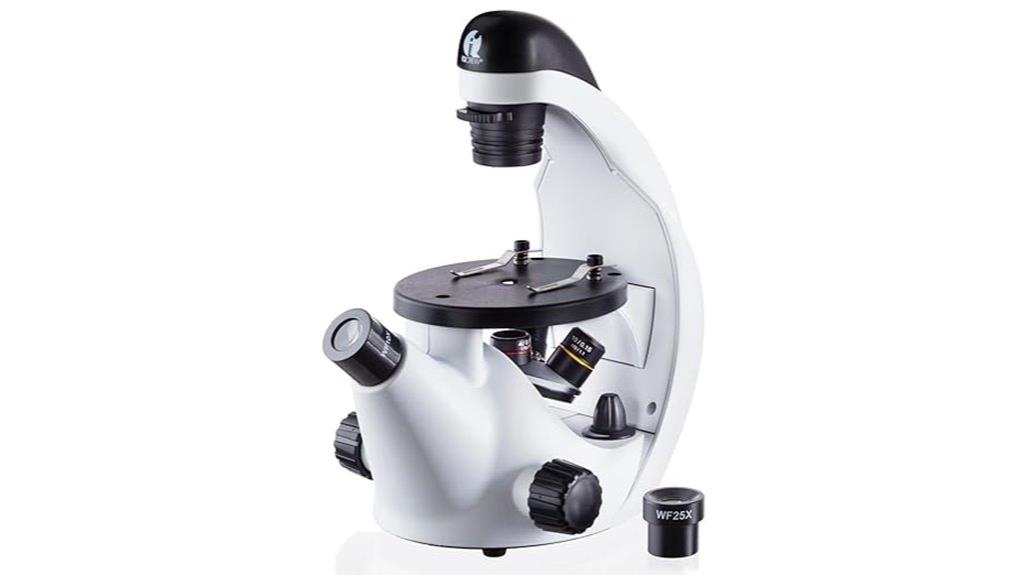
The IQCrew Inverted Student Microscope Kit (40X-500X) stands out as an excellent choice for young learners and students enthusiastic to explore the microscopic world. Its inverted design lets users view a wider range of specimens, including liquids and crystals, making it versatile for educational experiments. The kit features high-quality lenses that provide true optical magnification from 40X to 500X, along with two eyepieces for broader viewing options. It includes prepared slides, tools for sample creation, and a Frost Crystal Experiment, fostering hands-on learning. This microscope inspires curiosity and enhances STEM skills, making it perfect for budding scientists.
Best For: young students and beginners eager to explore the microscopic world with an educational and versatile inverted microscope.
Pros:
- Offers true optical magnification from 40X to 500X for detailed viewing
- Includes prepared slides, sample creation tools, and a Frost Crystal Experiment for hands-on learning
- Inverted design allows for viewing a wider variety of specimens, including liquids and crystals
Cons:
- May require adult supervision or guidance for younger children during experiments
- Slightly bulkier or heavier than traditional upright microscopes, impacting portability
- Limited advanced features, making it less suitable for more experienced or professional users
IQCrew by AmScope 40X-200X Kids Inverted Compound Microscope for Students
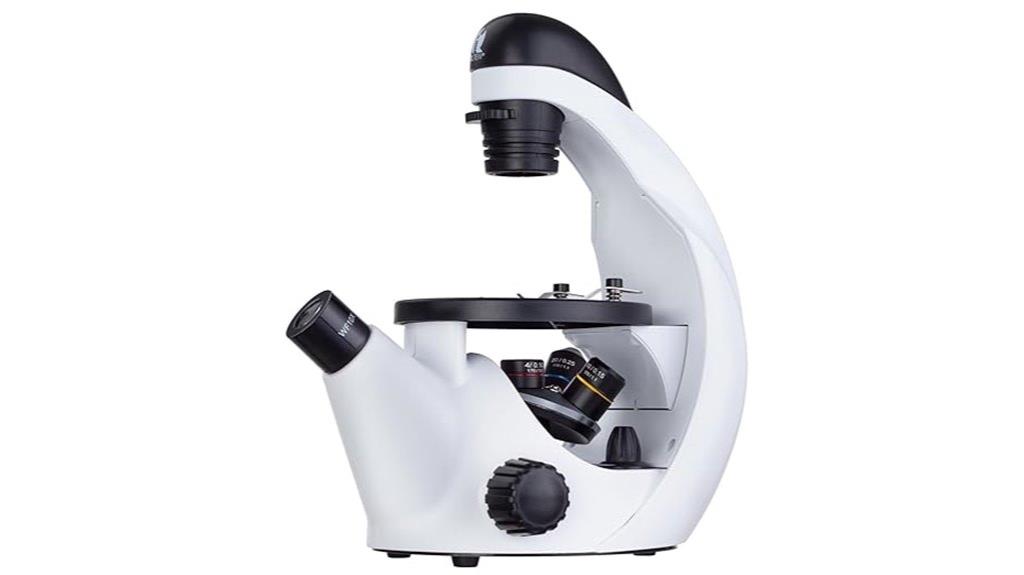
Designed specifically for young learners, the IQCrew by AmScope 40X-200X Kids Inverted Compound Microscope offers an accessible and engaging entry point into scientific exploration. With magnification ranging from 40X to 200X, it’s perfect for viewing liquids, crystals, and other specimens. The inverted design makes it easy to observe samples in petri dishes or beakers. It comes with prepared slides, tools for creating custom slides, and an all-inclusive learning set, making it ideal for students enthusiastic to explore biology. This microscope provides hours of hands-on learning, fostering curiosity and foundational skills in microscopy.
Best For: young students and beginners eager to explore biology and microscopy with an easy-to-use, educational instrument.
Pros:
- Adjustable magnification from 40X to 200X for versatile viewing options
- Inverted design facilitates viewing of specimens in petri dishes and beakers
- Comes with a comprehensive learning set including slides and tools for custom slide creation
Cons:
- Limited magnification range compared to professional microscopes
- Might require additional eyepieces to expand magnification beyond 200X
- Designed primarily for educational purposes, not suitable for advanced scientific research
National Geographic Inverted Microscope Set with Accessories

If you’re looking for an educational microscope that’s easy for kids to use and provides clear, detailed views of pond life, the National Geographic Inverted Microscope Set with Accessories is an excellent choice. It offers 40-400x magnification, making it perfect for exploring small specimens. The set includes a smartphone adapter, adjustable LED lighting, a height-adjustable stage, prepared and blank slides, and various tools like tweezers and a pipette. Its durable design and metal-glass lenses ensure quality without breaking the bank. Users praise its ease of use and educational value, especially since it simplifies slide handling and is suitable for children ages 10 and up.
Best For: educators, parents, and young science enthusiasts seeking an easy-to-use, educational microscope for exploring pond life and small specimens.
Pros:
- Easy to operate with simplified slide handling, ideal for children aged 10+
- High-quality metal and glass lenses provide clear, detailed images without breaking the bank
- Comes with a comprehensive set of accessories, including smartphone adapter, prepared slides, and tools for hands-on learning
Cons:
- Limited to 400x magnification, which may not satisfy advanced microscopy needs
- Heavier than some beginner microscopes at 5 pounds, potentially less portable for travel
- Might be less suitable for older students or professional use due to its focus on educational exploration
Professional Compound Microscope with Phone Adapter and Slides Set
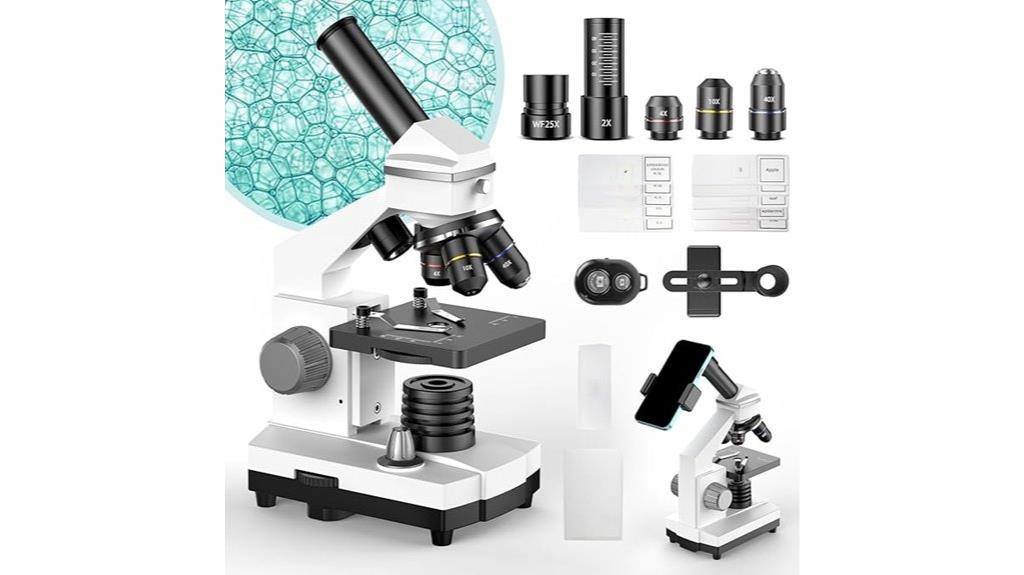
A professional compound microscope with a phone adapter and slides set is an excellent choice for students, educators, and hobbyists seeking detailed cell analysis. It offers 100X-2000X magnification with high-quality optics, including a WF25X eyepiece and multiple objective lenses. Built with a sturdy metal frame, it guarantees durability and smooth focus adjustments. Dual LED lights with adjustable brightness enhance specimen clarity, while the included accessories—prepped slides, a STEM kit, and a phone adapter—expand its versatility. Its user-friendly design makes it suitable for all ages, fostering curiosity and hands-on learning in biology, microbiology, and natural sciences.
Best For: students, educators, and hobbyists seeking a durable, versatile microscope for detailed biological observations and educational exploration.
Pros:
- High-quality optics with 100X-2000X magnification for detailed cell and microorganism viewing
- Sturdy metal construction ensures durability and steady focus adjustments
- Includes comprehensive accessories like prepped slides, STEM kit, and phone adapter for expanded learning
Cons:
- Assembly or setup of the phone adapter may require some trial and error for optimal use
- Slightly heavier weight (around 2.13 pounds) could affect portability for some users
- The complexity of features might be overwhelming for very young children without supervision
Microscope for Adults with USB Camera and Multiple Eyepieces
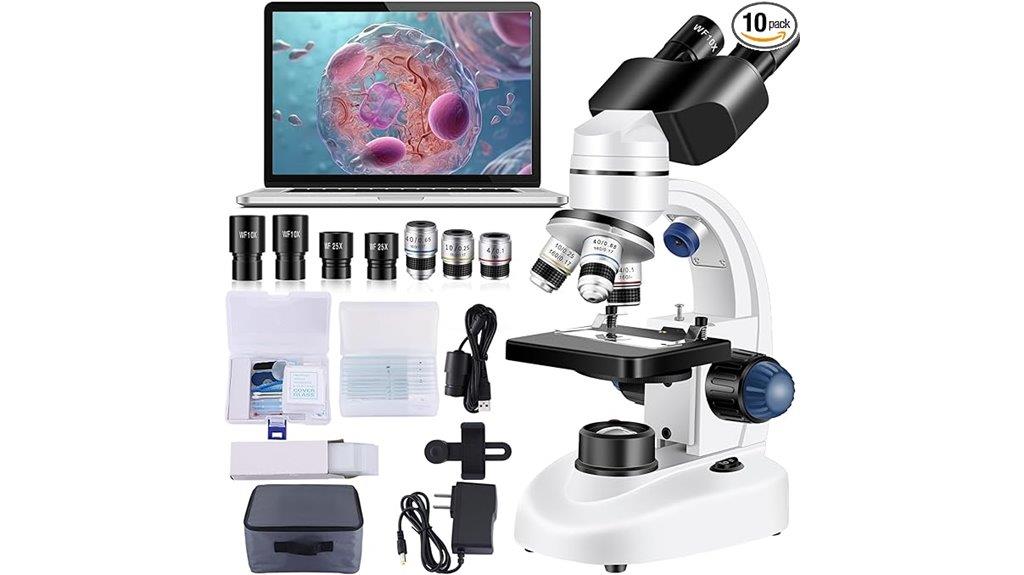
For adult users seeking versatile microscopy with advanced imaging capabilities, this microscope with USB camera and multiple eyepieces stands out as an excellent choice. It features WF10X and WF25X eyepieces with 40X to 2000X magnification, perfect for lab, school, or home use. The dual LED illumination ensures clear, detailed viewing under varying conditions. Its six magnification settings, from 40X to 2000X, allow precise observation of biological tissues, tiny objects, and structures. The USB 2.0 electronic eyepiece makes capturing photos and videos straightforward, enhancing documentation and analysis. With smooth focusing mechanisms and reliable support, this microscope offers an all-encompassing solution for detailed scientific exploration.
Best For: adult scientists, educators, and hobbyists seeking versatile, high-resolution microscopy with advanced imaging capabilities for research, education, or detailed analysis.
Pros:
- Wide magnification range from 40X to 2000X with multiple eyepieces and objectives for versatile viewing options
- USB 2.0 electronic eyepiece for easy photo and video capture directly to a PC
- Dual LED illumination system provides adjustable, high-quality lighting for clear images in various conditions
Cons:
- May be complex for complete beginners to operate due to multiple adjustable components
- Requires a compatible computer and software for image capturing and analysis
- Potentially higher cost compared to basic microscopes with fewer features
OMAX M82E Series LED Binocular Microscope

The OMAX M82E Series LED Binocular Microscope stands out as an excellent choice for researchers and students who require high-resolution imaging across a wide range of magnifications. It offers 8 levels from 40X to 2000X, thanks to four achromatic DIN objectives, providing detailed views for various applications. The adjustable LED illumination guarantees ideal lighting conditions, while the binocular head with customizable interpupillary distance and diopter enhances viewing comfort. Its sturdy metal frame, mechanical stage with scale, and precise focus knobs make it reliable and easy to use. Plus, the kit includes 100 slides and cover slips, making it versatile for different lab needs.
Best For: students, researchers, and laboratory professionals seeking high-resolution, versatile microscopy for detailed examination across a wide range of magnifications.
Pros:
- Offers 8 levels of magnification from 40X to 2000X for detailed imaging
- Adjustable LED illumination ensures optimal lighting conditions
- Sturdy metal construction and precise focusing mechanisms enhance durability and ease of use
Cons:
- May be heavier and less portable due to its metal frame
- Requires some familiarity to fully utilize the adjustable features
- The included accessories, while comprehensive, may not cover all specialized lab needs
Adult Trinocular Microscope with WF10x and WF25x Eyepieces
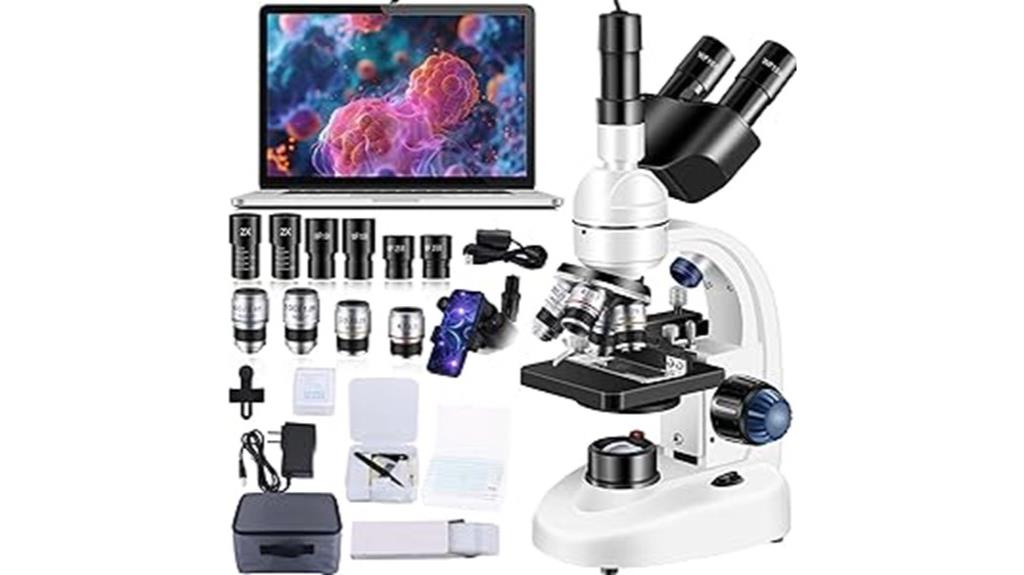
If you’re looking for a versatile microscope that offers both comfort and high-quality imaging, the Adult Trinocular Microscope with WF10x and WF25x Eyepieces is an excellent choice. It features a compound trinocular design with multiple eyepieces and 2x lenses, delivering clear, sharp images thanks to high pixel electronic eyepieces and a coated optical surface. The wide-angle eyepieces with adjustable diopter and pupil distance guarantee comfortable viewing for different users. Its advanced optical system with a 195 achromatic objective lens and infinity design minimizes light interference, supporting magnifications from 40X to 5000X, perfect for detailed biological observations.
Best For: educators, students, researchers, and professionals needing high-quality, versatile biological microscopy for detailed observations and laboratory work.
Pros:
- Offers high magnification range from 40X to 5000X for detailed imaging
- Comfortable wide-angle eyepieces with adjustable diopter and pupil distance
- Durable construction with high-quality optical coatings and an extensive accessory pack
Cons:
- May be heavier and less portable due to its professional, multi-component design
- Complexity of features might require some training for optimal use
- Higher price point compared to basic microscopes, reflecting its advanced capabilities
Compound Trinocular Microscope for Research and Education
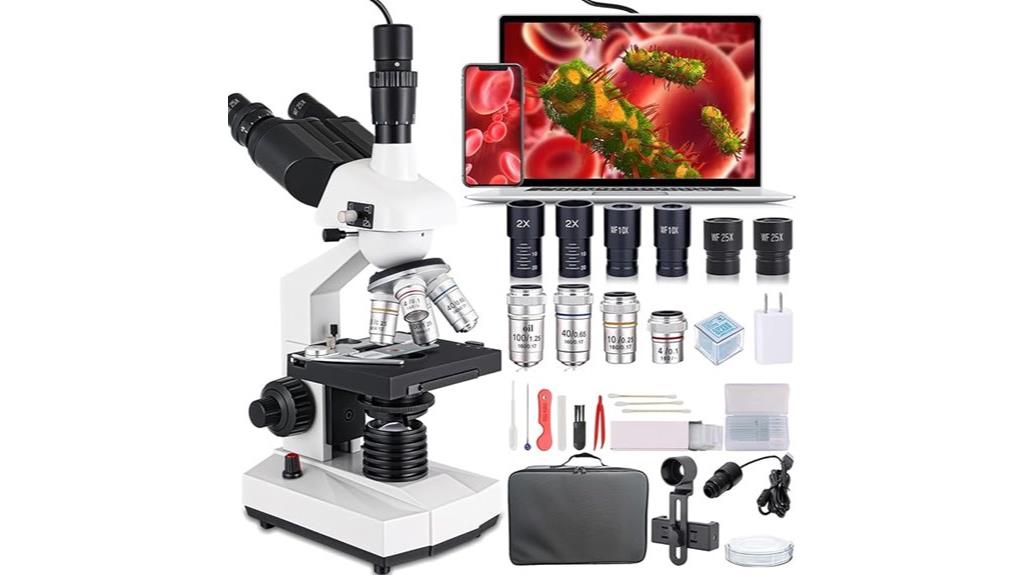
A compound trinocular microscope with 40X-5000X magnification stands out as an ideal choice for research and educational settings that demand detailed cellular observation. It features four achromatic objectives (4x, 10x, 60x, 100x), ensuring sharp, clear images while minimizing optical distortions. Equipped with LED brightfield lighting and a variable diaphragm, it offers excellent illumination control. The double-layer mechanical stage provides stable, precise X-Y movement, perfect for detailed specimen analysis. Its USB 1.3MP camera supports live streaming, recording, and image capture on Mac and Windows. Compact and portable, this microscope is perfect for labs, classrooms, and research projects that require high-quality imaging.
Best For: educators, researchers, and professionals seeking high-quality, detailed cellular imaging for research, teaching, or laboratory analysis.
Pros:
- Provides sharp, clear images with minimal optical distortions thanks to four achromatic objectives
- Features adjustable LED lighting and a mechanical stage for precise specimen observation
- Supports live streaming, recording, and image capture via USB camera compatible with Mac and Windows
Cons:
- Some users report difficulty adjusting the focus and stage movement smoothly
- Included accessories such as phone adapters and tools may be of lower quality and require replacement or adjustment
- Software setup and operation can be challenging, especially with outdated CDs and compatibility issues
Factors to Consider When Choosing Inverted Microscopes for Cell Culture
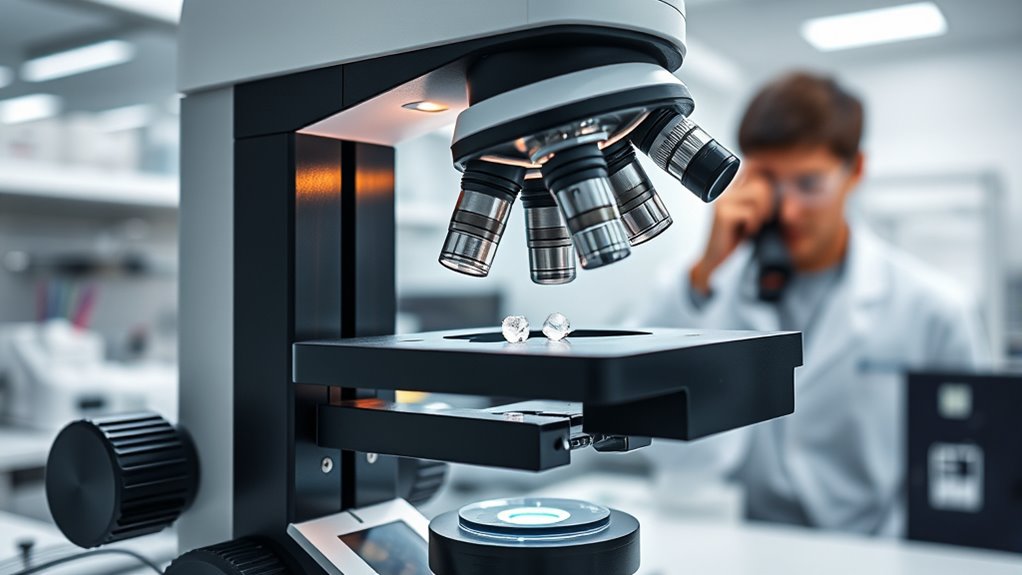
When selecting an inverted microscope for cell culture, I focus on optical clarity and resolution to guarantee sharp images. I also consider working distance flexibility and illumination quality for ease of use and ideal visualization. Additionally, I look at stage size, control options, and compatibility with imaging systems to meet my specific research needs.
Optical Clarity and Resolution
Optical clarity and resolution are vital factors in choosing an inverted microscope for cell culture, as they directly impact the quality of your observations. High-quality lenses, like plan achromatic objectives, reduce distortions and produce sharp, detailed images. Objectives with higher numerical aperture (NA) provide better resolution, revealing finer cellular details and enhancing contrast. Infinity-corrected optical systems improve image quality and allow for easy integration of accessories such as phase contrast or fluorescence modules. Surface coatings, including anti-reflective layers, minimize glare and improve image sharpness. Adequate illumination, with adjustable intensity and proper light source placement, is essential for evenly lit, clear images. Together, these features ensure you get precise, reliable views of your cell cultures.
Working Distance Flexibility
Choosing an inverted microscope with flexible working distances can greatly enhance your ability to work comfortably and efficiently with various cell culture vessels. Longer working distances make it easier to manipulate large or delicate containers without risking contact with the objectives, which is vital when handling petri dishes, multiwell plates, or flasks. Objectives with adjustable or inherently flexible working distances allow you to adapt to different sample sizes, increasing versatility. Fixed working distances can limit compatibility, requiring careful selection to prevent obstructions or damage. Additionally, longer distances provide extra space for accessories like phase contrast or fluorescence modules, which often need room between the objective and sample. Flexibility in working distance also improves ergonomics, reducing strain during long observation sessions.
Illumination Quality
Have you ever struggled to see cellular details clearly under inconsistent lighting? Illumination quality is critical when selecting an inverted microscope for cell culture. High-quality models offer adjustable brightness, allowing me to optimize visibility for transparent specimens. Consistent, even lighting without flickering or hotspots ensures accurate observation and sharp image capture. I prefer LED illumination because it provides a long lifespan, emits less heat, and is energy-efficient, creating a safer, more stable environment. Using filters like blue, green, or frosted glass can enhance contrast, revealing finer cellular details. Uniform illumination across the entire field of view minimizes shadows and glare, making focusing easier and analysis more reliable. Good illumination quality directly impacts the clarity, accuracy, and overall success of my cell culture work.
Stage Size and Control
A larger stage size, like 160mm x 250mm, is essential for handling bigger samples and multiwell plates in cell culture experiments. It provides ample space to maneuver and position specimens accurately without feeling cramped. This is especially important when working with multiple samples or complex setups that require precise placement. A bigger stage also improves stability, reducing vibrations that can affect image quality. Additionally, good stage control features, such as smooth X-Y movement and fine adjustment knobs, enable precise positioning and focus. Some microscopes offer motorized stages, allowing for automated or programmable movement, which saves time and enhances reproducibility. Overall, selecting a microscope with sufficient stage size and responsive control mechanisms ensures efficiency and accuracy during your cell culture observations.
Compatibility With Imaging
When selecting an inverted microscope for cell culture, ensuring compatibility with imaging systems is essential for capturing high-quality, detailed images. I look for microscopes with a compatible trinocular or camera port that allows seamless attachment of digital cameras or imaging devices. The optical system should support high-resolution imaging, including features like infinity correction and plan achromatic objectives, to produce sharp, clear images. I also verify that the camera compatibility includes necessary adapters, such as 0.5x or 1.0x reduction lenses, for ideal image capture. Additionally, I check whether the microscope’s software and hardware support live viewing, recording, and post-processing functions that integrate smoothly with my computer. Lastly, I consider accessories like smartphone adapters and specialized imaging modules to enhance image quality and convenience.
Ease of Operation
Choosing an inverted microscope that’s easy to operate can make a significant difference in your cell culture work. Intuitive controls and straightforward focusing mechanisms help you quickly locate and observe delicate samples without frustration. Features like motorized stage movement and automatic focus reduce manual effort, increasing precision and saving time. Clear labeling of adjustment knobs and ergonomic design minimize fatigue, especially during long sessions, and make it easier for new operators to learn quickly. User-friendly software interfaces for image capture and analysis streamline workflows and lower technical barriers. Accessibility features, such as large control dials and adjustable workstations, further enhance comfort and handling during extended use. Prioritizing ease of operation ensures smoother workflows and more reliable results in your cell culture research.
Frequently Asked Questions
What Are the Compatibility Requirements for Camera Attachments?
Camera compatibility requires checking the microscope’s trinocular port type, often C-mount or photo port, and ensuring the camera’s connector matches. I always verify the camera’s sensor size and resolution to suit my imaging needs. Additionally, I look for software compatibility and whether I need adapters or specific mounting brackets. Ensuring these requirements are met helps me get clear images and seamless integration with my workflow.
How Does Magnification Range Impact Cell Culture Observation?
Magnification range really shapes what I can see in cell cultures. A wider range allows me to switch between detailed views and broader overviews, which is essential for observing cell behavior at different scales. If the range is too narrow, I might miss important details or struggle to find the right focus. So, I look for microscopes with versatile magnification options to guarantee thorough, flexible observations.
What Maintenance Practices Extend Microscope Lifespan?
Keep your microscope in top shape by following essential maintenance practices—think of it as giving your gear a tune-up. I regularly clean the lenses with appropriate solutions, avoid touching the glass with bare hands, and cover it when not in use. I also check and calibrate the light source and keep the moving parts lubricated. These steps help prevent wear and tear, extending my microscope’s lifespan and ensuring clear, reliable observations.
Are There Specific Models Suitable for High-Throughput Screening?
Absolutely, I recommend models like the Olympus CKX53 or Nikon Eclipse Ti2 for high-throughput screening. These microscopes offer fast autofocus, motorized stages, and excellent image quality, making them ideal for batch processing large sample sets. Their automation features reduce user fatigue and increase efficiency, so I find them perfect for busy labs aiming for rapid, reliable results without sacrificing precision.
How Important Is Ergonomic Design for Prolonged Use?
Ergonomic design is vital for prolonged use because it directly impacts comfort, reducing fatigue and strain during long sessions. I find that a well-designed microscope with adjustable eyepieces, comfortable grips, and a stable stand helps me maintain focus and productivity. If it’s uncomfortable, my concentration drops, and I risk repetitive strain injuries. For anyone spending hours on cell culture, prioritizing ergonomic features isn’t just nice; it’s essential for health and efficiency.
Conclusion
Choosing the right inverted microscope can feel like a coincidence—you find the perfect features just when you need them most. Whether it’s a camera port for capturing images or adjustable lighting for clarity, these top picks are designed to meet your cell culture needs. I’ve seen how the right tool can transform research, making discovery feel almost serendipitous. So, trust your instincts—your ideal microscope might be closer than you think.
